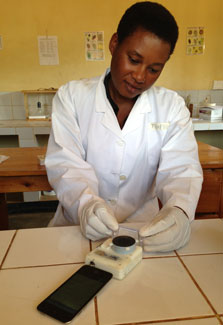Lab-on-a-chip provides speedy disease diagnoses
January / February 2015 | Volume 14, Issue 1

Photos courtesy of T. Laksanasopin/
Columbia University
The lab-on-a-chip prototype, mChip, can detect
HIV and syphilis in only a few drops of blood
from a finger prick.
by Cathy Kristiansen
Co-infection with syphilis or genital herpes can compound the spread of HIV, but these diseases are all treatable - if they are diagnosed. Many global health systems struggle to pay for costly laboratory tests, so researchers have developed a potentially inexpensive, portable diagnostic tool, ideal for remote locations without electricity.
The lab-on-a-chip prototype, mChip, can detect HIV and syphilis in only a few drops of blood from a finger prick. It is powered by a nine-volt battery and takes less than 20 minutes to provide clear-cut results. The NIH’s
National Institute of Nursing Research (NINR) and other funders supported the development and testing of the tool. Dr. Samuel Sia, of Columbia University, led the research. In Rwanda field studies, mChip detected HIV and syphilis with lab-standard accuracy. Test results from this device can be transmitted by cell signal or satellite to medical records databases.
The researchers plan to continue refining the new tool, for instance by finding ways to reduce its temperature sensitivity and lower its cost to enable widespread availability in developing countries. In a report in
Nature Medicine, they suggest the technology could be adjusted to identify markers for other infections such as gonorrhea and Chlamydia as well, leading to treatment and lessening the global burden of sexually transmitted diseases.
More Information
- Learn more about the
National Institute of Nursing Research (NINR), and the NINR-supported project
A Low-cost Point-of-care Diagnostic Test for Simultaneous HIV-1 and STIs.
- Related publications:
- Sia SK et al.
A smartphone dongle for diagnosis of infectious diseases at the point of care.
Science Translational Medicine, February 4, 2015
- Chin CD et al.
Mobile device for disease diagnosis and data tracking in resource-limited settings.
Clinical Chemistry, April 2013
-
A low-cost, point-of-care diagnostic test for HIV-1 and other sexually transmitted diseases [Video].
Nature Video, Uploaded July 29, 2011
- Chin CD et al.
Microfluidics-based diagnostics of infectious diseases in the developing world.
Nature Medicine, July 2011
- Addae-Mensah KU et al.
Actuation of elastomeric microvalves in point-of-care settings using handheld, battery-powered instrumentation.
Lab Chip, October 2010
- Parsa H et al.
Effect of volume- and time-based constraints on capture of analytes in microfluidic heterogeneous immunoassays.
Lab Chip, August 2008
To view Adobe PDF files,
download current, free accessible plug-ins from Adobe's website.